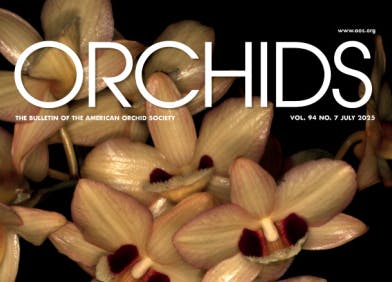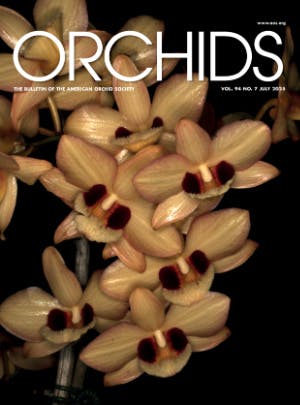
We have all done it… sunburned our orchids. Maybe we moved them out of their winter homes into too bright light, put them in the yard during a rainstorm and forgot them when the sun came out or just did not pay attention to the changing sun patterns. Sunburn happens fast, beginning as a bleached spot and developing into a black, necrotic mess in severe cases. Sunburn typically occurs on the leaf where the sun angle is the most direct, when the sunlight strikes the leaf perpendicular to its surface. More oblique sun angles have a lesser chance of causing sunburn.
[1–3] Sunburn typically occurs on the high point of the leaf where the sun angle is most direct.



Each plant has a maximum light saturation point, the maximum amount of light that it can absorb and convert into chemical energy. If exposed to higher levels of light, it will absorb the energy of the light without being able to process it, so the internal leaf temperature will increase to potentially unsafe levels, possibly resulting in sunburn. For most plants, the light saturation point occurs at about 25 to 50% of full sunlight. When exposed to excess light, leaves must dissipate the surplus absorbed light energy to prevent damage to the photosynthetic apparatus, otherwise known as sunburn.
The most important ways i n which leaves dissipate excess heat is through convective cooling, where heat is transferred from the leaf to the air circulating around it, and evaporative cooling, where transpiration of moisture through the stomata removes a large amount of heat, cooling the leaf. Proper plant shading during the hot summer months to reduce light intensity along with good air movement and good irrigation practices help dissipate excess heat and are critical to preventing sunburn.
Once you have tortured your plants a few times, you learn that sunburn has a pretty distinctive appearance. Sometimes a leaf can be damaged just short of being sunburned and has a bleached look, but the damage always first appears on the highest point of the leaf exposed to the most direct sunlight. There were some plants in the greenhouse that had that bleached sort of pre-sunburn look, but the damage was not where it should have been.
[4] Splotches of slighted raised light green tissue on upper leaf surface, no sporing bodies on either surface, spots almost look like they are bleached as if close to sunburn

The symptoms seem to begin with one or two slightly raised bleached areas on the upper surface of the leaf. It looks like the beginning of sunburn on the leaf, although the discolored splotches are not on the highest point of the leaf receiving the most direct sunlight, where you would expect the sunburn to begin. As the damage progresses, the color changes from light green to tannish, and the tissue becomes slightly sunken from the surrounding leaf. Typically, there is no discoloration or markings on the leaf underside. In advanced stages, the tissue can turn to dark brown in the center of the discolored blotchy patch and becomes more sunken, with the discoloration apparent on the lower leaf surface. Often found on seedlings, it does not seem to impair growth, and the symptoms do not seem to spread readily to other plants.
[5] Bleached area of slightly sunken light tan tissue on upper surface of leaf. Visible veins in leaf in bleached area. No markings on leaf underside.

After a conversation with Dave Off, in which he noticed the same thing in the Waldor greenhouses, we decided to send some samples off to Waypoint Analytical for analysis. The Waypoint report stated that there were isolated Colletotrichum species present, the fungus responsible for causing the leaf spotting disease anthracnose: “In most cases, this disease is considered more aesthetic than life-threatening. Efforts for reducing the spread of disease include avoiding overhead sprinkling and reducing humidity by improving ventilation. Removal of infected leaves is also very helpful since it reduces the amount of the fungus available to infect new tissues. Control can also be achieved with the use of fungicide sprays applied as soon as symptoms are visible.” Dave reported they have stopped the progression of the disease by spraying with thiophanate methyl (Thiomyl, Clearys 3336, T-Methy). Pageant and Phyton 27/35 are also reported to be effective for controlling this disease. The fungicides suitable for treating anthracnose are also effective on the other leaf spotting fungi.
[6] Two large blotchy spots, but not on the highest point of the leaf where you would expect the sunburn to occur. Bleached light tan spots, has brown scarring sunken tissue over bleached areas. In area of worst damage, there is brown showing on the leaf underside

[7] Two splotches of slightly raised light green tissue on upper surface, one would be in right place for sunburn and the second wouldn’t be, nothing on leaf undersides.


These are mild cases of anthracnose in cattleyas. We have seen more severe damage as we wrote about in several articles about leaf spotting fungi in cattleyas: Part 1 - The New Anthracnose, Part 3 - Anthracnose and Anthracnose in a Cattleya Alliance Plant (Bottom 2025ac). The symptoms in cattleyas often look different from the damage seen in thin leaved orchids. Perhaps even the tough, waxy cuticles of cattleyas would benefit from a periodic preventative spraying program.



References:
Bottom, S.
Part 1 - The New Anthracnose. https://staugor - chidsociety.org/pdf/LeafSpottingFungi-Part1-NewAnthracnosebySueBottom.pdf. Accessed online 3/6/25 .
Part 3 – Anthracnose. https://staugorchidsociety.org/pdf/ LeafSpottingFungi-Part3-AnthracnosebySueBottom.pdf Accessed online 3/6/25.
Anthracnose in a Cattleya Alliance Plant. https://staugorchidsociety.org/pdf/AnthracnoseOnCattleyaAlliancePlantbySueBottom.pdf. Accessed online 3/6/25.
Taiz L. and E. Zeiger. 2014. Plant physiology and development: 6th revised edition. SINAUER Associates Inc. U.S., Chapter 9 Photosynthesis: Physiological and Ecological Considerations
— Sue Bottom started growing orchids in Houston in the mid–1990s after her husband Terry built her first greenhouse. They settled into St. Augustine, Florida, Sue with her orchids and Terry with his camera and are active in the St. Augustine Orchid Society, maintaining the Society’s website and publishing its monthly newsletter. Sue is also a member of the AOS Editorial Board (email: sbottom15@ gmail.com).












